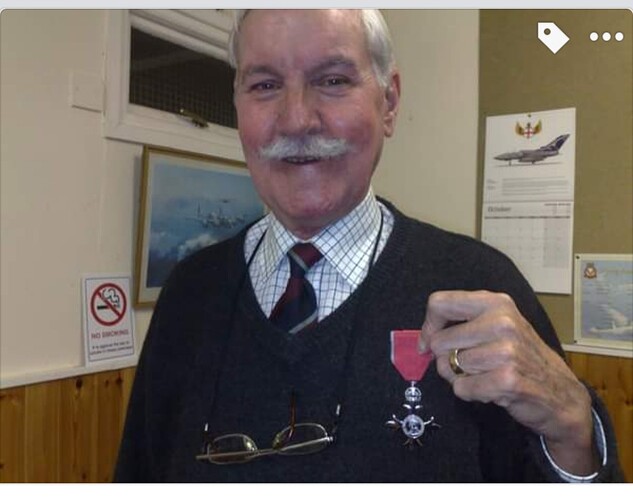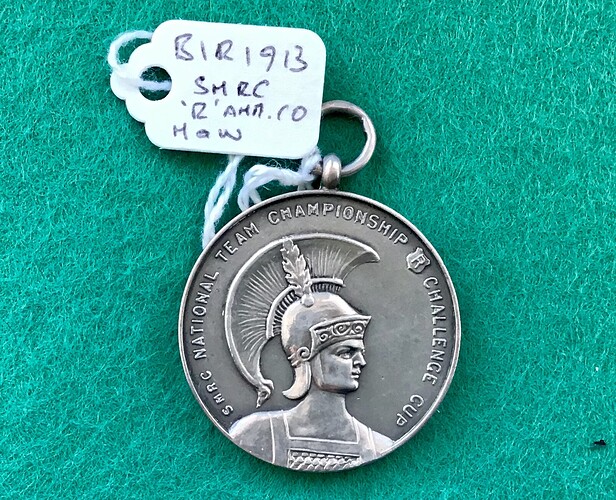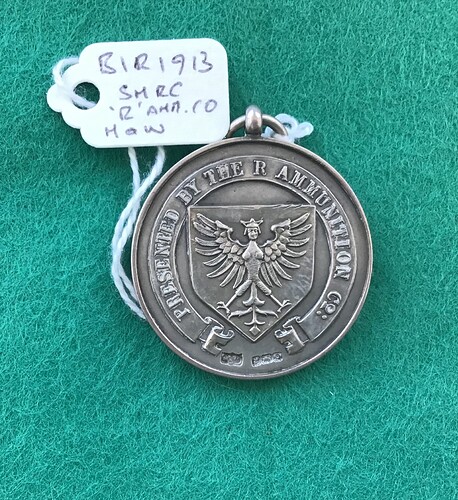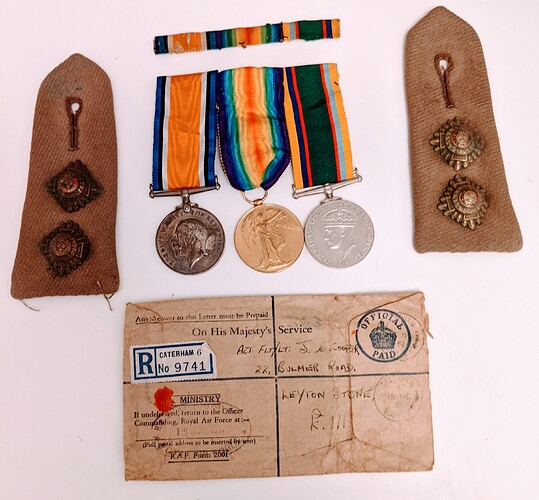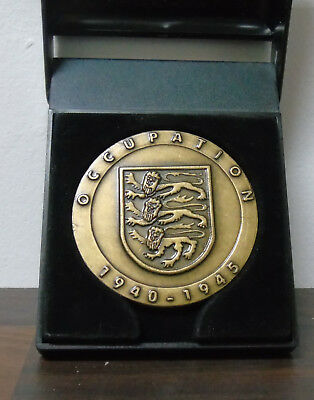
Not strictly my photo, but a photo of something that has come to me via inheritance, and just to add to the medal collection already on show here.
Gunner,
What do you think the value is of an OBE sent by recorded delivery as the king was ill. It has its original Wrapping and a hand written letter letter from the king to the recipient??
Well I’m damned…
That must have been taken shortly after he received the MBE as its not yet mounted with his CFM and NSM (unofficial medal).
I’ll have a look in the Medal Year Book and come back to you but probably around £200-£350 or thereabouts, depending on which type it is, who the recipient is, what he did to be awarded the OBE and it’s present condition.
Thank you for your insight. I will definitely give it a look. It seems like such a vast hobby but breaking into different types and time periods definitely helps. Got to start somewhere!
A great place to start is WW1. Do you have any particular affiliation to a place in the UK (you could collect to men who came from there) or to a particular Regiment that maybe a relative served in?
For example, my WW1 theme is pairs (British War Medal & Victory Medal) and trios (1914\1914-15 Star, British War Medal & Victory Medal) to my grandfathers regiments, 10th Royal Hussars, 18th Hussars and the Durham Light Infantry.
Or you could devote yourself (and your available funds!) to gallantry groups, maybe specifically to the RAF in general or to a particular Squadron? My advice is to start cheap and work up from there. A medal collection is really an inert cash fund and they only increase in price over time.
Another piece of advice I’d give is to subscribe to Ancestry and\or Find My Past. It’s amazing what can be found out about the recipients of your medals. I’ve got a Royal Observer Corps Long Service Medal awarded to a guy who served in the Army in WW1. His medal index card shows he’s entitled to a WW1 pair. He left the Army to enlist in the RAF and after completing his training, he deserted with his service record annotated as such. Somehow, he must have been forgiven, enlisted in the ROC and went on to be awarded the LSM sometime in the 50’s. He must have been active in the Corps during WW2 so would have earned at least one other medal, so his full entitlement could be: British War Medal (non-forfeited for desertion), Victory Medal, Defence Medal and ROC Long Service Medal.
Not bad for a deserter!
Does this thread need renaming to “medal collections” or similar or split into a medal topic?
Does seem to have gone off the topic…
I was wondering that myself
Pip, Squeak & Wilfred
Yep and when there were only the British War Medal and Victory Medal, they were known as “Mutt & Jeff”.
Mods - feel free to split.
There are peripheral and more specialist areas where quite rare items can be found at reasonable cost. Shooting in the late 19th and early 20th centuries is closely connected with the military of the period. The National Rifle Association (NRA) and Society of Miniature Rifle Clubs (SMRC) were both formed with the objective of supporting the defence of the realm. Below is an interesting medal with a little twist.
The SMRC National Team Championship was first competed for in 1914. It was sponsored by the R Ammunition Company whose badge is on the reverse.
For reasons that I am sure are obvious neither the design or sponsorship were used the following or subsequent years.
My newest addition to the collection. He served in the Suffolk Regiment in WW1 and then later became a Flt Lt in the VR(T). I’m needing to try and do some research but I’m guessing he was at 12F as his CFM was sent to his address in Leytonstone
Does anyone know if RAFVR(T) service in the UK counted for the Defence Medal?
The Defence Medal was awarded for non-operational service in the Armed Forces, the Home Guard and other approved civilian services during the period from 3 September 1939 to 8 May 1945 (2 September 1945 for those serving in certain specified territories in the Far East and the Pacific),
In the United Kingdom, those eligible included military personnel working in headquarters, on training bases and airfields for the duration of the War in Europe from 3 September 1939 to 8 May 1945, and service by members of the Home Guard during its existence from 14 May 1940 to 31 December 1944. The medal was also awarded for non-operational service overseas in the Dominions of the Commonwealth and in British Colonies.
Eligible civilian service in the United Kingdom included, but was not confined to, civilian services whose members were eligible for Chevrons for war service.
Civil Defence services established by a Government Department or Local Authority.
- Wardens Service, including Shelter Wardens.
- Rescue Service, including former First-Aid Party Service.
- Decontamination Service.
- Report and Control Service.
- Messenger Service.
- Ambulance Service. including Sitting Case Cars.
- First-Aid Service, including First-Aid Posts and Points, Public Cleansing Centres, Mobile Cleansing
Units and the Nursing Service for public air-raid shelters.
- Local Authority Civil Defence Services.
- Rest Centre Service.
- Emergency Food Service, including the Queen’s Messenger Convoy Service.
- Canteen Service.
- Emergency Information Service.
- Mortuary Service.
- National Fire Service including service in a local authority Fire Brigade or the [Auxiliary Fire Service]
- The Police including Special Constabulary (with 3 years service), Royal Marine Police Special Reserve, Admiralty Civil Police, War Department Constabulary, Air Ministry Constabulary, Railway Police and Dock Police.
- American Ambulance, Great Britain
- Civil Air Transport.
- Civil Defence Reserve, Kent County Civil Defence Mobile Reserve and West Sussex County Civil
Defence Mobile Reserve.
- Civil Nursing Reserve.
- Civilian Technical Corps.
- HM Coastguard
- Fire Guards who performed duties under the local authorities, or at Government or business premises.
- Lighthouse keepers who served under the three Lighthouse Authorities and keepers of Light-Vessels under those authorities, who did not qualify for the 1939–1945 Star.
- Nurses in hospitals for which Government Departments or Local Authorities were responsible, or in the recognised voluntary hospitals.
- Port of London Authority River Emergency Service.
- Clyde River Patrol.
- Royal Observer Corps
- Women’s Voluntary Services for Civil Defence, whose members could qualify provided they:
- were enrolled in an eligible local authority Civil Defence Service;
- performed duties analogous to those of one of the eligible local authority Civil Defence Services, and the section of the Women’s Voluntary Services to which they belonged was one which functioned operationally during or immediately after enemy attacks.
The length of qualifying service required for the award of the Defence Medal varied, depending on where and in what role an individual served.
- For persons normally resident in the United Kingdom, the requirement was 1,080 days (three years) of service in the United Kingdom or 90 days (three months) of service in a Mine and Bomb Disposal Unit.
The qualifying period in the United Kingdom ended upon the end of the War in Europe on 8 May 1945.
-
In a non-operational area, not subjected to air attack and not closely threatened, the requirement was 360 days (one year) of service overseas from or outside the individual’s country of residence. Military service in certain areas overseas from the United Kingdom could qualify up to 2 September 1945, when the war in the Pacific ended. Service was reckonable from the date of embarkation and was counted at its full rate for the voyage to the non-operational area.
-
In a non-operational area subjected to air attack or closely threatened, the requirement was 180 days (six months) of service overseas from or outside a person’s country of residence. The same applied to British Commonwealth citizens from overseas who served in the Home Guard in the United Kingdom. Service was reckonable from the date of embarkation and, for the voyage to the area of service, was counted at half the actual duration of the voyage.
So unless we can ascertain the status of the VR (Training Branch) during WW2, I don’t think we can say one way or the other whether they were eligible for the DM.
Where’s wilf_san when you need him?!
Have heard from another source on the book of faces (who may be on here as well) that they didn’t qualify for War Chevrons so didn’t qualify for the Defence Medal.
Have also n informed he was OC of 1107 (Leytonstone) in 1941. That squadron merged with 12F in 2000 .
As I’ve seen items for sale on some of these threads, I thought that I’d likewise advertise (with the mods permission) some medals for sale. I’m looking to thin out one particular theme of my collection so that I can concentrate on other areas of interest and the stock below may help budding collectors get off to a start. The prices displayed are ‘buy it now’ prices as anything that doesn’t sell here, will be sent for bidding on Ebay. All prices don’t include postage:
WW1
Victory Medal (impressed: 21483 Pte J Waterson Lancs R) - £15.00
WW2
Africa Star (unnamed as issued) - £15.00
Burma Star (unnamed as issued) - £15.00
Jubilee
1887 QV Golden Jubilee Medal (Bronze) (City of London Police issue - unnissued medal) - £100.00
1887 QV Golden Jubilee Medal with 1897 clasp (Bronze) (Met Police issue\14,000 issued\engraved: PC T.Weaver F Div) - £75.00
1887 QV Golden Jubilee Medal with 1897 clasp (Bronze - other ranks) (600 issued) - £350.00
1887 QV Golden Jubilee Medal with 1897 clasp (Silver - officers, ladies and gentlemen) (1,012 issued) - £350.00
1897 QV Diamond Jubilee Medal (Bronze) (LCC MFB issue\950 issued\engraved: J.W Henry) - £110.00
1897 QV Diamond Jubilee Medal (Bronze) (Met Police issue\7,481 issued\engraved: PC W.Lewis N Div) - £80.00
1897 QV Diamond Jubilee Medal (Bronze) (SJA Bde issue\910 issued\engraved: Pte B.Audus) - £105.00
1897 QV Diamond Jubilee Medal (Bronze - other ranks) (890 issued) - £225.00
1897 QV Diamond Jubilee Medal (Silver - officers, ladies and gentlemen) (3,040 issued) - £150.00
1897 QV Diamond Jubilee Medal (Silver) (Mayor & Provosts issue\512 issued) - £395.00
1935 GV Silver Jubilee Medal (85,234 issued) - £35.00
1977 EIIR Silver Jubilee Medal (30,000 issued) - £175.00
1977 EIIR Silver Jubilee Medal (Canadian version) - £130.00
2002 EIIR Golden Jubilee Medal (300,000+ issued) - £50.00
2002 EIIR Golden Jubilee Medal (Canadian version) - £99.00
2012 EIIR Diamond Jubilee Medal (465,000 issued) - £50.00
2012 EIIR Diamond Jubilee Medal (Canadian version) - £99.00
As members can appreciate, space precludes me from posting a picture of every single medal, however, I’m happy to PM pictures if someone is interested in a particular item.
checks bank account excitedly
Is disappointed
Will have a think over the next couple of days but may be able to pick up one or two of them, even if I want a lot more.
Great to see fellow collectors within the Corps!
I collect to the following themes:
4th Btn KSLI TA - WW1
Shropshire Yeomanry / 10th Btn KSLI TA - WW1
1st Btn KSLI - Korea
1st Btn, Herefordshire Regiment (including Herefordshire Rifle Volunteers, Militia and Light Infantry)
The Royal Air Force 1918 - 1939 (Must contain an India General Service Medal)
OMRS 7628
BMS
Several times I’ve noticed a strange curiosity in WWI medals…
I keep seeing examples where the ribbands of the War Medal and the Victory Medal are transposed.
I.e. the War Medal is fitted with the multicoloured ribband and the Victory Medal the blue and gold.
I had a few pass through my hands for mounting and it was clear from the creases in the ribbon (one being suspended from a ring and the other from a bar) that they had been in place for many years.
After that I started looking more closely at museum examples and I’ve spotted loads of instances.
It seems most likely that they had been issued with the wrong ribbands attached.
Has anyone else noticed this too?
Think it was more lack of information at the time.
The 1914 and 1914/15 stars were sent out in 1919. The BWM/VM in a combined box in the mid 1920’s hence a 50/50 chance! No useful medals/ribbons slip like with WW2.
Another spanner in the works would be the proposed Inter Allied Victory Medal ribbon with the flag colour stripes rather than the watered rainbow!
